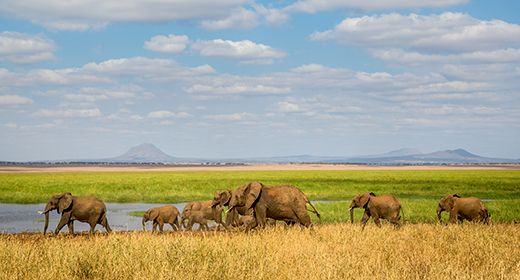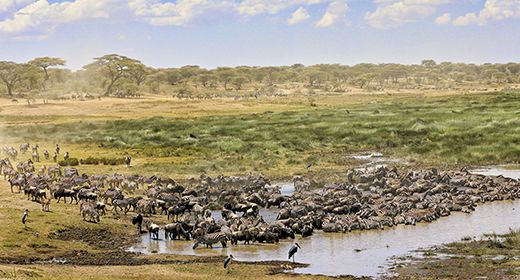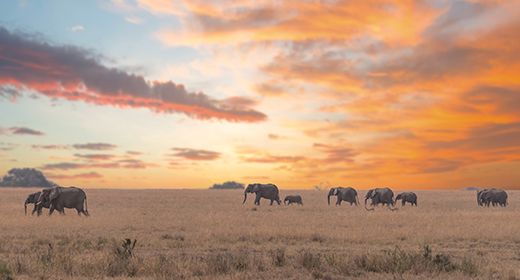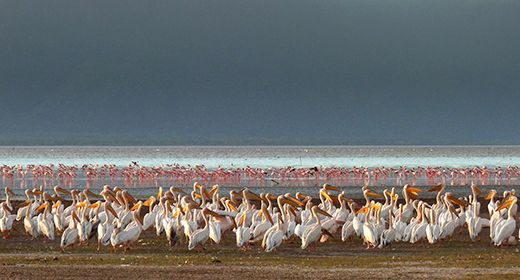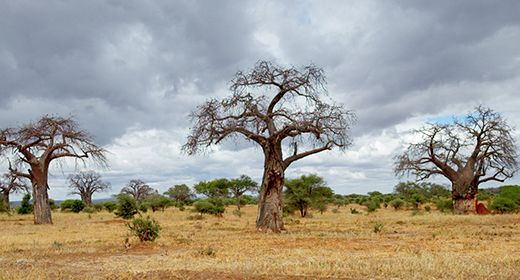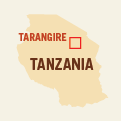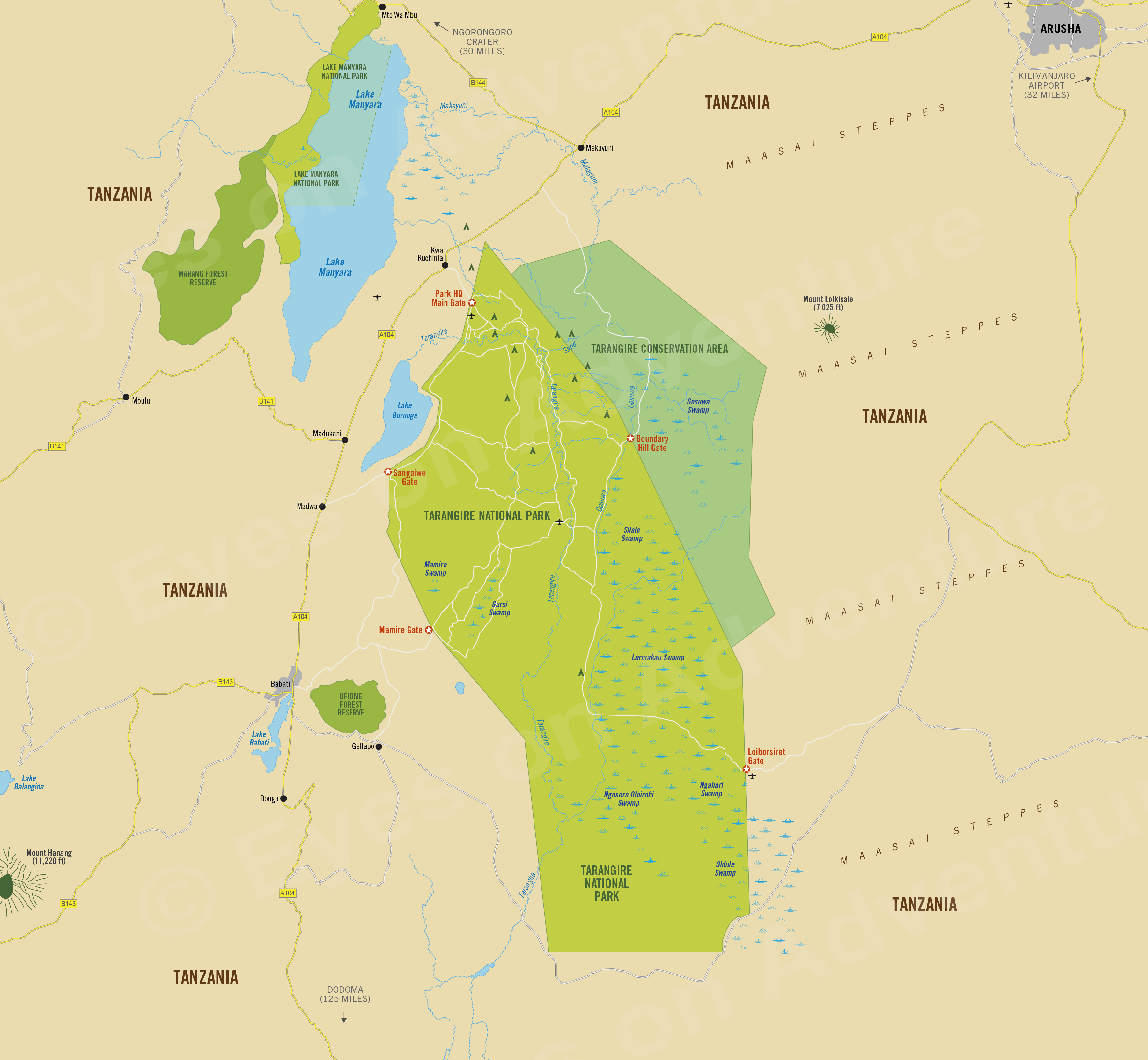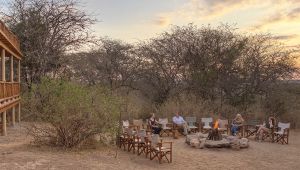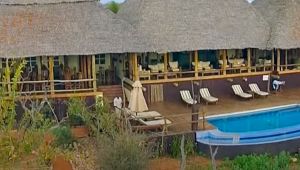Tarangire
(incl. Tarangire National Park, Tarangire Conservation Area)
Region Links: Great Migration, Kilimanjaro & Arusha, Ngorongoro & Manyara, Serengeti, Southern Tanzania, Tarangire, Western Tanzania, Zanzibar
Highlights
- Tarangire's mammal migration of elephants, wildebeests, zebras, oryx, more
- Highest density of animals during the dry season between July-October
- Lions, leopards, buffalo, elephants and more are in Tarangire year-round
- Spectacular birding destination with over 500 species recorded
- Iconic baobab trees and the Tarangire River
EOA Recommends: Chem Chem Safari Lodge, Nimali Tarangire, Oliver's Camp, Sanctuary Swala Camp
Tarangire is home to Tanzania's second-highest concentration of wildlife and offers superb safaris without the crowds.
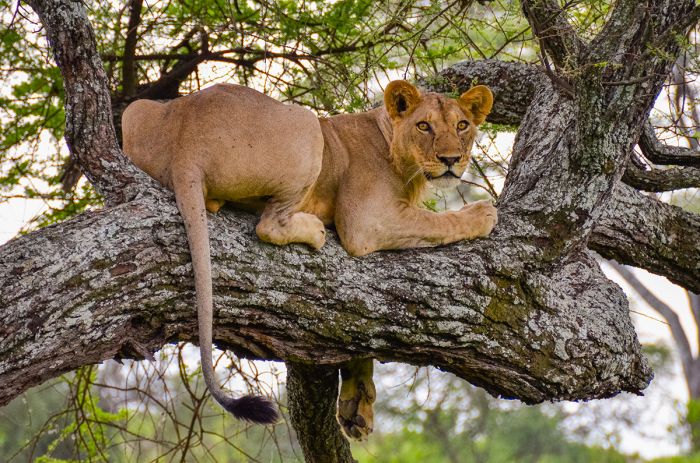
Lion resting in a tree in Tarangire National Park.
The least visited of northern Tanzania's wildlife reserves, Tarangire could be called the country's best-kept wildlife secret. It even has its own mammal migration, albeit on a smaller scale than the Serengeti's.
The park is based around the permanent Tarangire River, which empties into Lake Burunge just west of the park's border. During the dry months, the river attracts abundant wildlife from the surrounding areas.
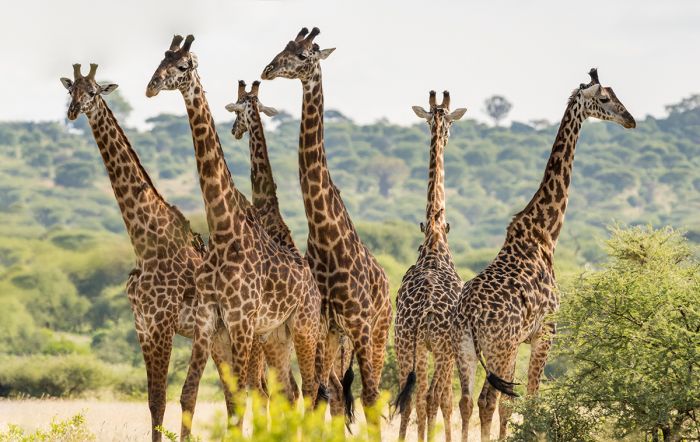
Giraffes in Tarangire National Park, Tanzania.
Tarangire is home to a great diversity of wildlife, including four of Africa's Big Five (elephant, lion, leopard, and buffalo - only rhino are missing). Other permanent residents include giraffe, zebra, oryx, impala, hartebeest, eland, warthog, baboon, vervet monkey, and more. Birding in the park is excellent.
The park contains a variety of habitats, with the northern area protecting grassland plains, riparian woodland, acacia scrub, and spectacular baobab trees. Further south, the park is defined by seasonal swamps, which are excellent for wildlife and birds. The far south is very remote and only accessible in the dry season.
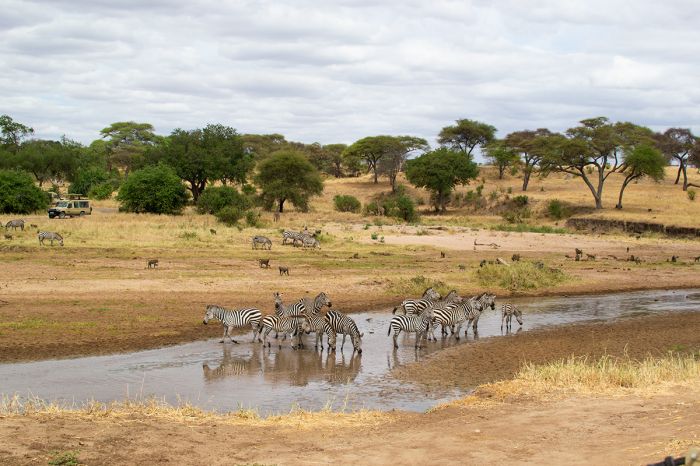
Zebras and baboons in Tarangire.
Tarangire should certainly be considered on any northern Tanzania circuit and is easily combined with Manyara, Ngorongoro, and the Serengeti.
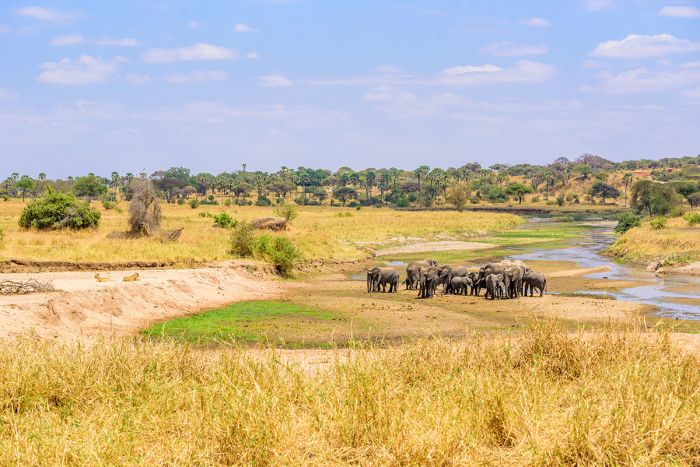
Two lions watching a herd of elephants in the Tarangire River.
Read More...
Lake Burunge, Migration, Tarangire Conservation Area (TCA), Tarangire National Park, Tarangire Region, Wildlife
Tarangire Region
Tarangire is comprised of the Tarangire National Park and the adjoining Tarangire Conservation Area, which together occupy nearly 1 250 square miles (3 250 sq kms) of wilderness in Africa's Rift Valley. It is part of Tanzania's northern safari circuit, which also includes the Serengeti, Ngorongoro, and Lake Manyara.
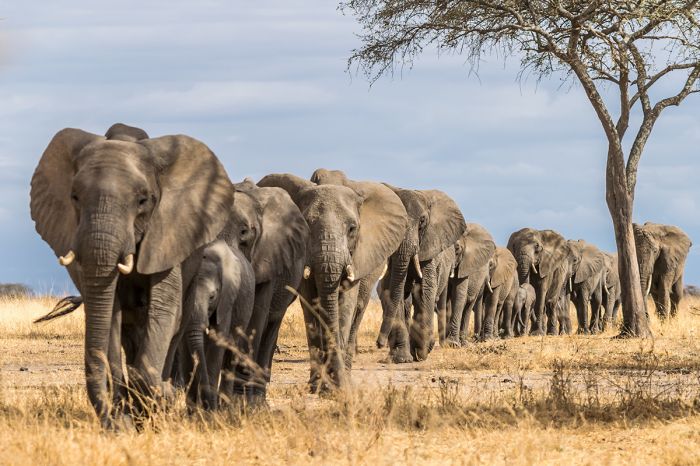
Elephants are one of Tarangire's most numerous mammals.
Tarangire's core protected area is based around the Tarangire River, which flows north through the 1 010-square-mile (2 616-sq-km) Tarangire National Park before emptying into Lake Burunge. An additional 226 square miles (585 sq kms) is protected as the Tarangire Conservation Area (TCA). To the east are the Maasai Steppes, covering roughly 1 900 square miles (5 000 sq kms) of unprotected, but mostly uninhabited land.
The Tarangire region is drier than the Serengeti, with dense Acacia scrubland and woodlands, especially in the north and along the rivers. Tarangire's baobab trees are a notable feature in the northern area of the national park. Seasonal swamps dominate the southern half of the park.
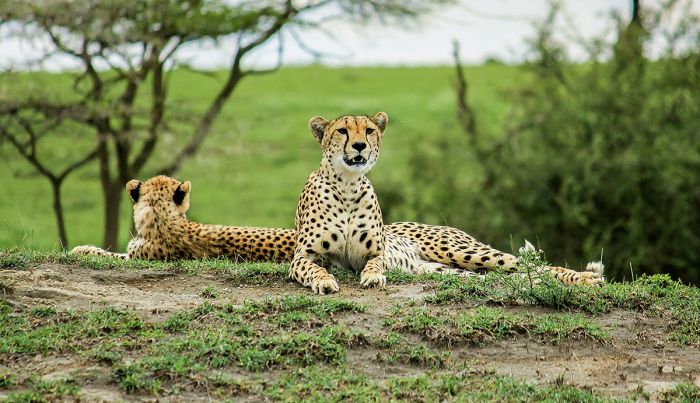
Young male cheetahs in Tarangire.
Tarangire National Park
Tarangire National Park was established in 1970 to protect the large numbers and diversity of wildlife, birds, and habitats along the perennial Tarangire River.
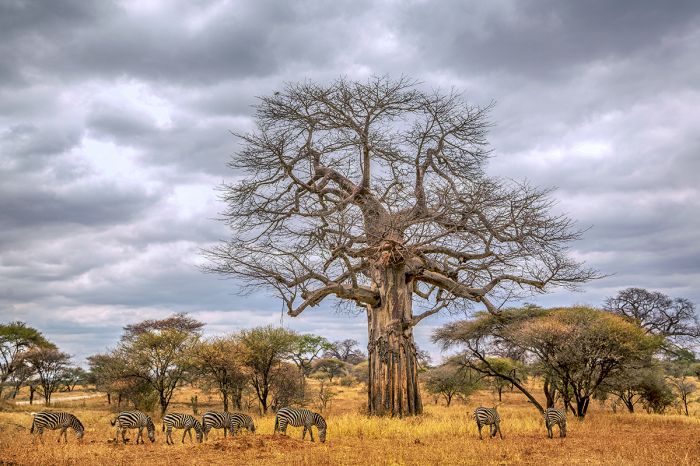
Zebras graze by a baobab tree in the northern sector of Tarangire National Park.
The northern portion of the park is the most developed and offers year-round safaris. The bend of the Tarangire River and the east-west portion is particularly good for wildlife. The north is dominated by hilly grasslands, Acacia woodlands, patches of riparian woodland along the Tarangire River, and numerous baobab trees. The road network here is well established, with tracks running on either side of the Tarangire River.
Moving south, the park gradually becomes defined by seasonal marshes, which are a haven for birds. Most of the roads in this central portion of the park are passible all year, though some become difficult in the rainy season. The far south is extremely remote and is only reachable in the dry season, but even then, is virtually unexplored.
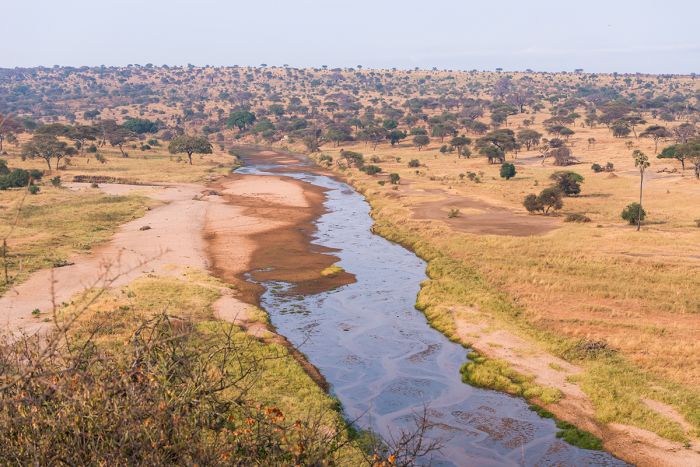
The Tarangire River provides water to the park's abundant wildlife.
The Tarangire River, which flows north through the entirety of the park, is the life source for the entire region. Even during the peak of the dry season (August-October), when most of the region has little to no water, the mostly dry Tarangire riverbed still supports life-sustaining pools of water.
Wildlife from across the region congregate at the Tarangire River for its water, including huge numbers of elephants, and herds of wildebeest and zebra. The animals spend the dry months here, providing excellent game viewing. Once the short rains begin in November, the animals disperse into the surrounding areas.
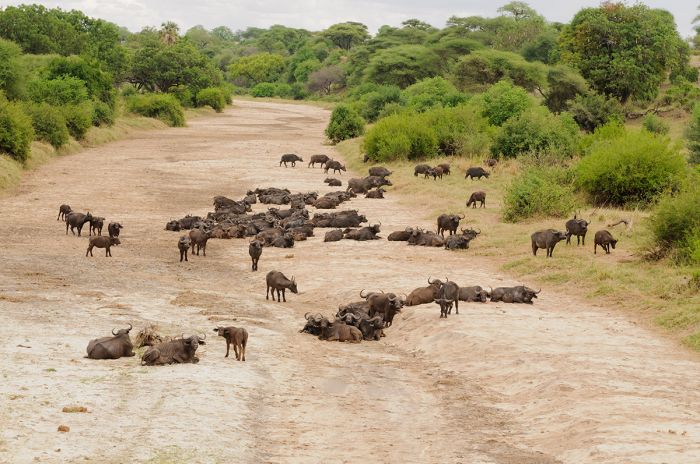
A herd of buffalo in the dry Tarangire River bed.
Tarangire's swamps are located in the central and southern reaches of the park and offer some of the country's richest breeding ground for birds during the rainy season between November and May. In the dry season (June-October), the swamps shrink, but the remaining marshland offers superb game viewing, especially for buffalo, lion, and elephant.
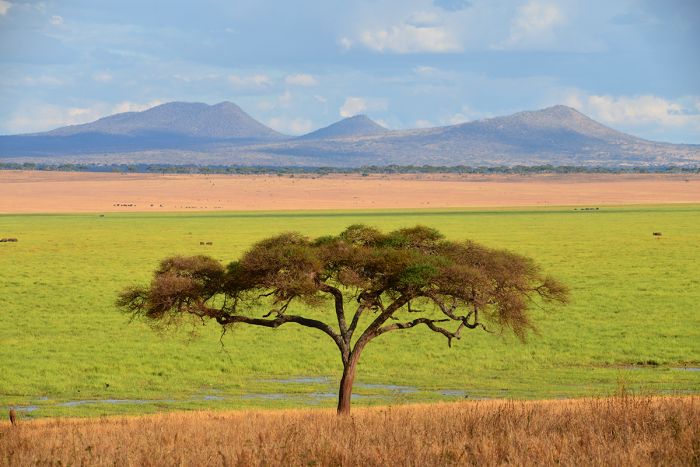
Elephants in Tarangire's swamps.
Tarangire Conservation Area (TCA)
Bordering the national park in the northeast is the Tarangire Conservation Area (TCA). The TCA was established in the late 1990s as Tanzania's first community-managed wildlife area.
The TCA is comprised of multiple Wildlife Management Areas (WMAs) that are owned and managed by separate groups of Maasai communities. Some of these WMAs offer eco-tourism as a source of revenue for their land, while others are used for cattle grazing or mixed-use purposes.
The TCA was used for trophy hunting for decades until this land was returned to its historical Maasai inhabitants and the local tribes were given official title to the land.
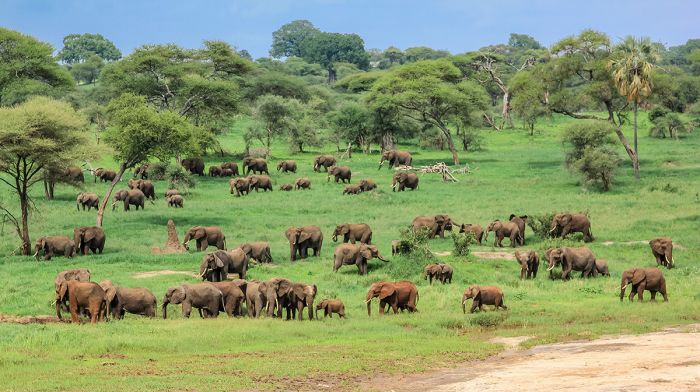
A large congregation of elephants in the Tarangire Conservation Area.
The Tarangire River's primary watershed is found in the TCA and these seasonal "sand" rivers, provide pools of water during the dry season for an abundance of wildlife. Game viewing in the TCA can even surpass that in the national park.
The TCA is not subject to national park regulations, so night drives and walking safaris are an option at the various safari camps located here.
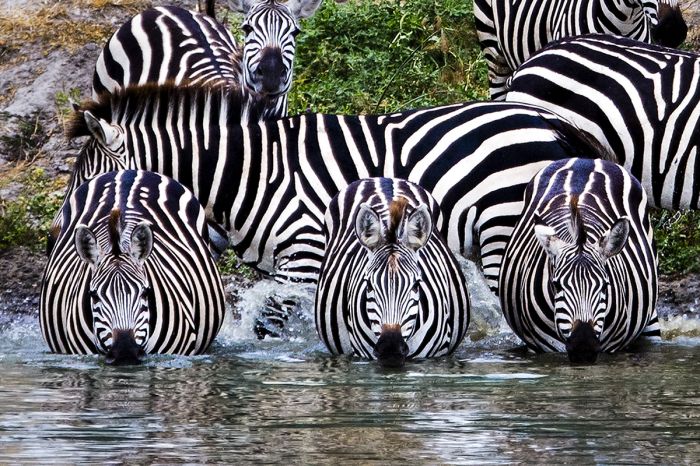
Zebras drinking in Tarangire National Park.
Lake Burunge
Lake Burunge is a shallow, alkaline lake located just beyond the park's western border. The lake is fed by the Tarangire River and it is home to huge flocks of flamingos and pelicans during the dry months from July thru October.
Burunge has no outlet, so the salt and mineral content is too high for drinking except after good rains between November and May. When rain water fills the lake, elephants and other animals are commonly seen around the lake. The level of the lake fluctuates widely and it often dries up completely by the end of the dry season, with only a salty crust left on its surface.
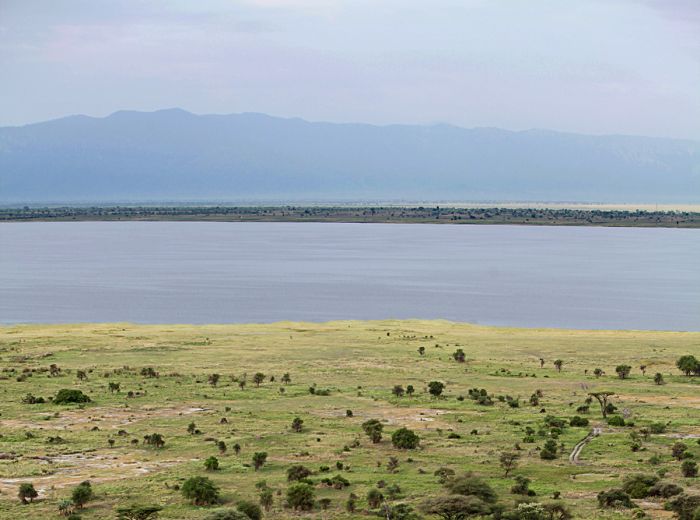
Aerial view over Lake Burunge.
Wildlife & Migration
Tarangire is home to a little-known wildlife migration, which is much smaller than the great Serengeti-Mara migration. The annual migration at Tarangire consists of some 25 000 wildebeest, 30 000 Burchell's zebra, 2 500 elephant, and modest numbers of fringe-eared oryx. The concentration of mammals in Tarangire in the dry season months (July-October) is second only to the Serengeti and Ngorongoro Crater in Tanzania.
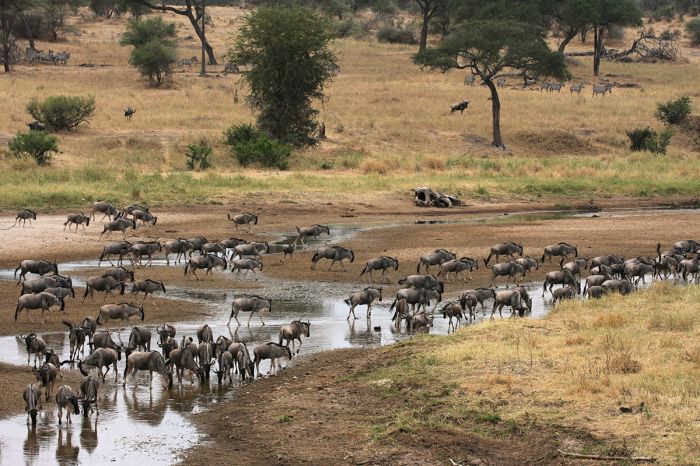
Wildebeests and zebras at the Tarangire River during the dry season.
These animals begin to arrive at the onset of the dry season (usually in late July) to take advantage of the remaining water and waterholes along the Tarangire River bed and its watershed tributaries. The herds remain in Tarangire until the rains arrive, usually sometime in November. When the short rains in November begin in earnest, the zebras and wildebeests depart Tarangire, heading north to Lake Manyara or east into the Maasai Steppes.
By the time the long rains arrive in April/May, the migrating animals are spread out over a huge area roughly ten times the size of Tarangire National Park. Some elephants migrate all the way into Kilimanjaro and Amboseli National Park. When the long rains are over and the plains begin to dry up (usually between mid-May and early June), the animals start to head again towards Tarangire, where by August, they have arrived in huge numbers again.
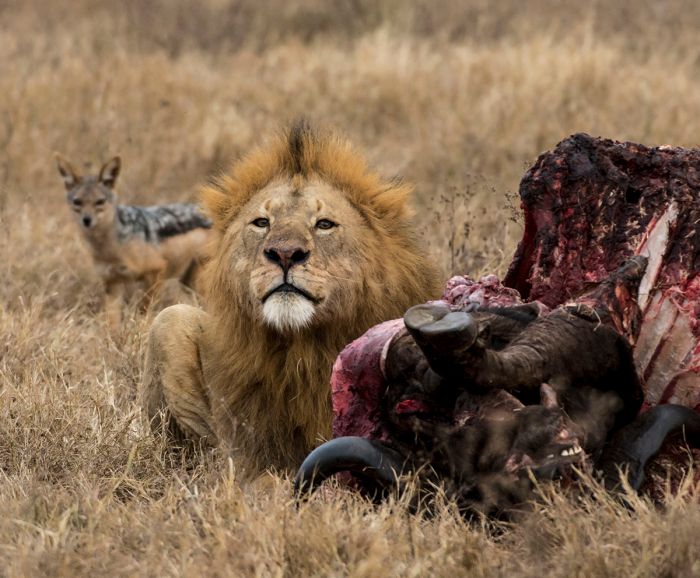
A male lion guards a buffalo kill as a black-backed jackal looks on.
Many of Tarangire's animals are year-round residents, including lion, leopard, buffalo, giraffe, zebra, eland, waterbuck, bushbuck, Thomson's gazelle, Coke's hartebeest, impala, warthog, hippo, black-backed jackal, ostrich, olive baboon, vervet monkey, and significant numbers of elephant. Cheetah are seen here but are uncommon, as are spotted hyenas. Less common mammals include the odd-looking gerenuk antelope, with its extra long neck, lesser kudu, and striped hyena.
Birding in Tarangire is superb, with over 500 species recorded. The Tarangire River and the swamps are especially productive birding areas. West of the park's boundary is Lake Burunge, which attracts a variety of waterbirds all year and large numbers of flamingos in the dry season.
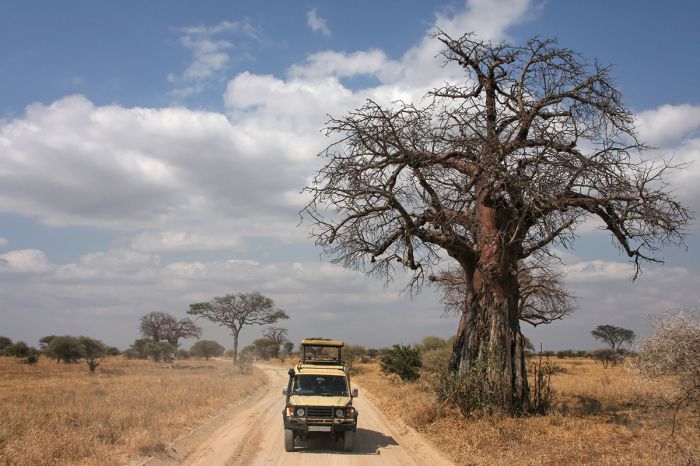
Game drive and baobab tree in Tarangire.
Read More...
Lake Burunge, Migration, Tarangire Conservation Area (TCA), Tarangire National Park, Tarangire Region, Wildlife
Great Good Fair Poor
- Jan
- Feb
- Mar
- Apr
- May
- Jun
- Jul
- Aug
- Sep
- Oct
- Nov
- Dec
Seasons
Tarangire's weather is best described in terms of its rainy and dry seasons. Northern Tanzania experiences its rain between November and May, with two somewhat defined rainy seasons.
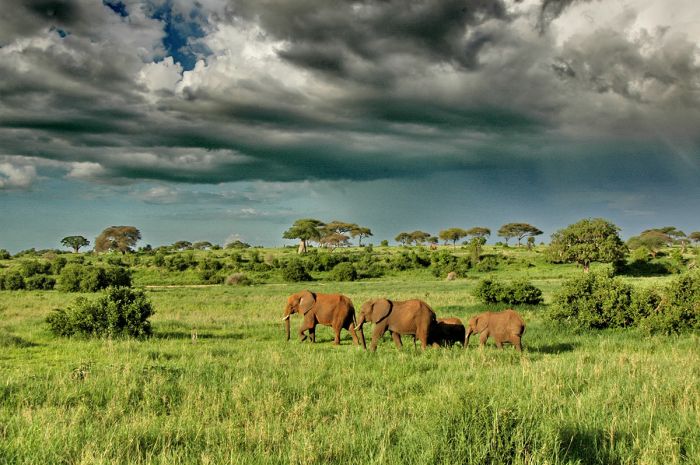
Elephants in Tarangire during the rainy season.
The "short rains" (called the "mvuli"), which fall in November and into mid-December for around four weeks, typically occur as short afternoon showers. The "long rains" (called the "masika") come in April and May, with heavy afternoon downpours that can sometimes set in for many hours. January thru March are mostly rain-free, but the rains still fall sporadically and unpredictably.
The dry season is June thru October and little to no rain falls in the Tarangire region at this time.
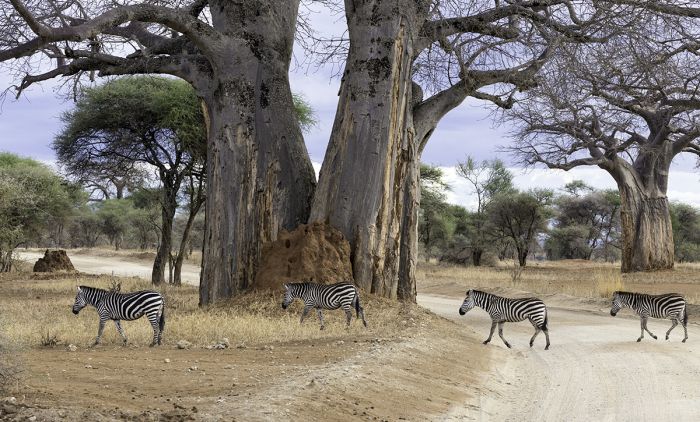
Zebras walk beneath a baobab tree in the dry season.
MIGRATION
Tarangire's migration is different to the Serengeti-Mara migration in several ways... it is smaller, the timing is different, and it consists of many species of animals, not just wildebeests and zebras.
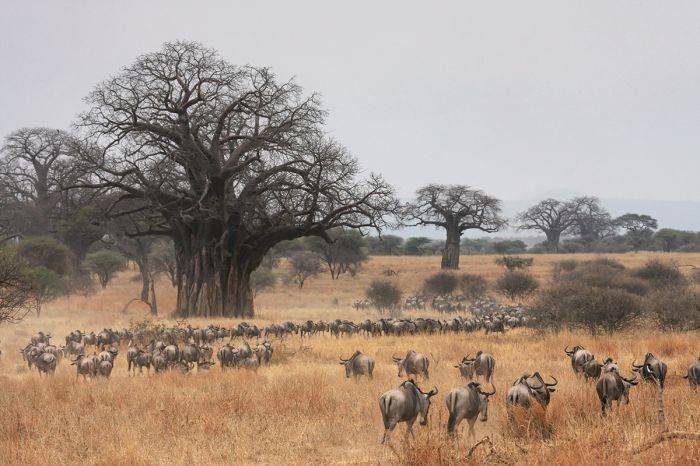
Tarangire's migration during the dry season.
The main species in Tarangire's migration are elephant, blue wildebeest, Grevy's zebra, eland, and fringe-eared oryx. These animals all arrive in Tarangire to survive the dry season months on the regions' only available water at this time, the Tarangire River. Although the river is not flowing at this time, there are pools of water along its course through the national park, and this is enough for thousands of animals to sustain themselves as they await the rains that arrive in November.
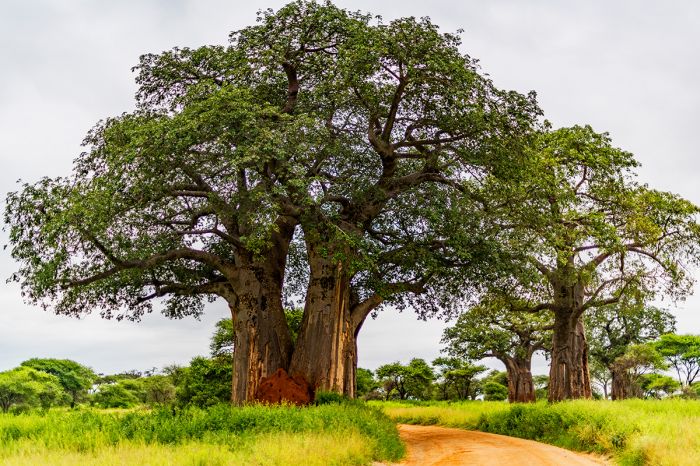
A lovely baobab in Tarangire during the rainy season.
Game Viewing
The migrating herds that live in Tarangire during the dry months of July thru October make these the prime game-viewing months. Big herds of elephant, buffalo, zebra and wildebeest can be found along the Tarangire River at this time.
Predators, including lion and leopard are here in good numbers. Spotted and striped hyenas, jackals, and caracals are also here. Cheetahs are uncommon.
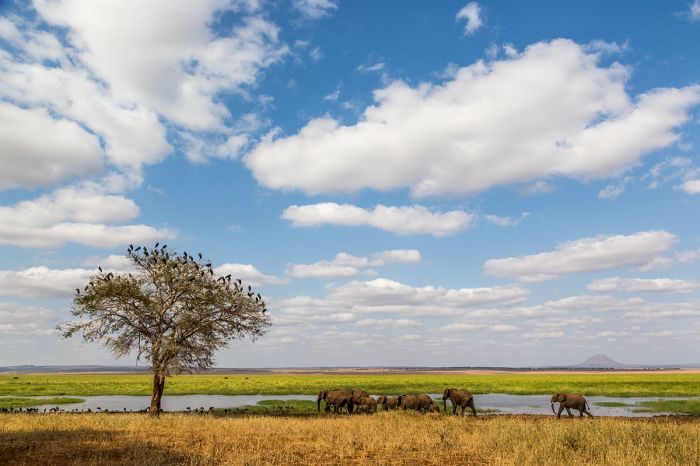
Elephants in one of Tarangire's marshes.
Once the rains begin (usually in November), many of the animals that have congregated along the Tarangire River to survive the dry season, begin to disperse into the surrounding land outside the national park.
Elephants head north and east, some all the way to Kilimanjaro and Amboseli. The zebras and wildebeests head towards Lake Manyara, Ngorongoro, and Lake Natron. Some of the gazelles and antelopes spread out to the east into the Maasai Steppes. The buffalo generally do not go far, most moving south in the park into the swamps and marshes, which are filling up with rain water.
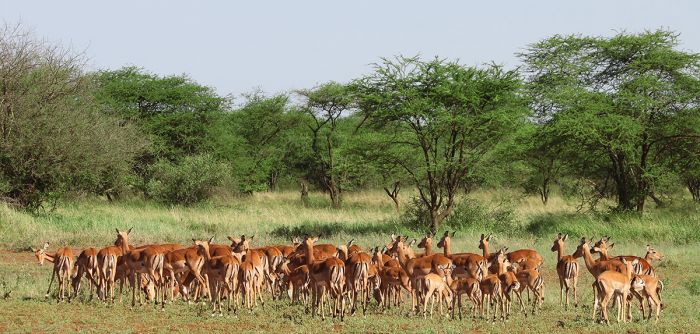
A large herd of impala in Tarangire.
Some animals do not depart Tarangire and they stay in the national park all year, even during the rainy season. These include waterbuck, impala, giraffe, kudu, warthogs, and some of the elephants.
The best game viewing in Tarangire is August thru October. November is still good, but depending on the timing of the first good rains, some of the animals have begun to spread out away from the river and park.
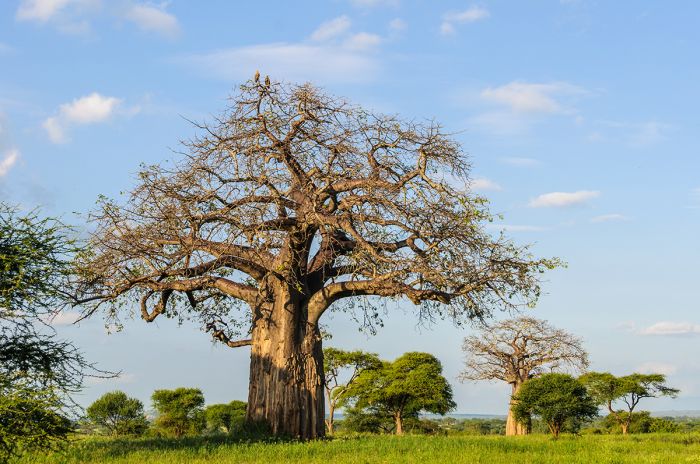
A pair of eagles atop one of Tarangire's iconic baobab trees.
December thru April are fabulous for birding. The park is very green, but the game viewing can be challenging. Some of the roads in the central and southern portion of the park may be closed. The accessible marsh areas are tremendously good for birding.
June and July are the beginning of the dry season and game viewing improved. The first of the migrating mammals to return to Tarangire are the fringe-eared oryx, followed by elephants, and eventually the zebras and wildebeests. Predator sightings are very good at this time and the drying up of the bush makes it easier to spot animals.
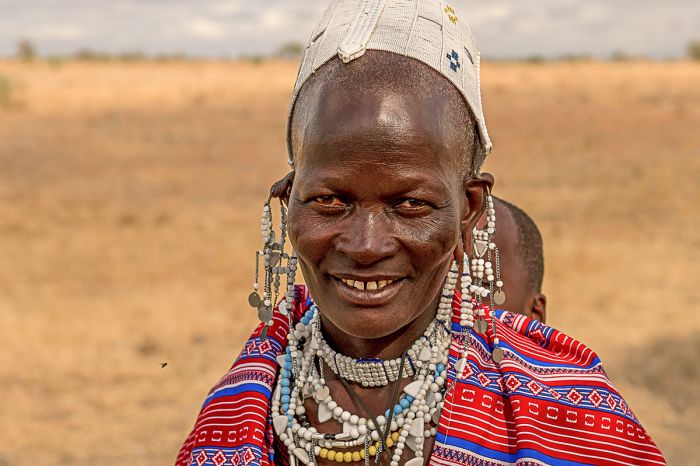
A Maasai woman in Tarangire.
Tarangire River
The Tarangire River runs north through the length of Tarangire National Park. The river does not flow all year, but during the dry months, small pools still exist in the riverbed. Underground water is also accessed by elephants by digging in the riverbed. These small waterholes along the river provide life-sustaining water for thousands of animals in Tarangire in the rain-free months of July thru October.
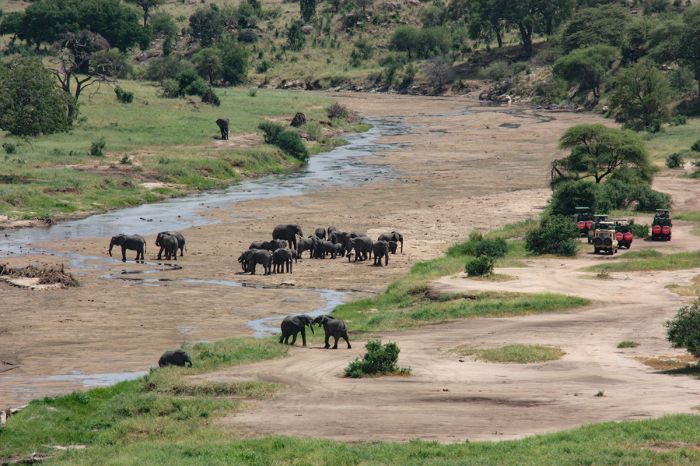
Elephants and game drive vehicles along the Tarangire River.
Temperatures
The overall climate in Tarangire is temperate and comfortable all year.
The dry season months of June thru October very are pleasant, with afternoon temps reaching 78-80°F (26-27°C) and clear skies. Nighttime temps fall to around 55-58°F (13-14°C).
The rainy season brings precipitation and somewhat warmer temperatures. Daytime temps average 80-84°F (27-29°C), while overnight temps drop to around 59-62°F (15-17°C).
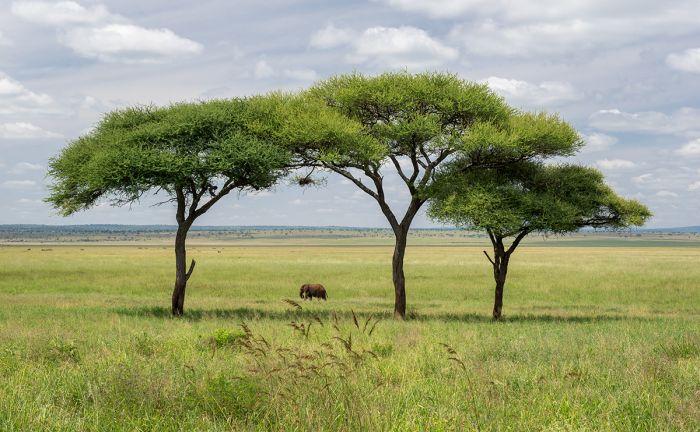
A lone elephant crosses the grassland in Tarangire.
Showing 1–2 of 2 results
Classic safari camp located in the remote southern portion of the park with easy access to the wildlife-rich swamps. Superb wildlife viewing during the dry season, including the Tarangire Migration. Day and night drives, walking, ballooning.…




